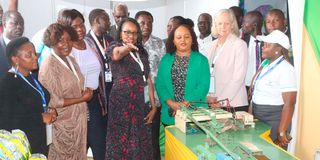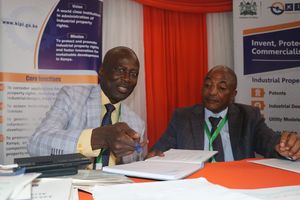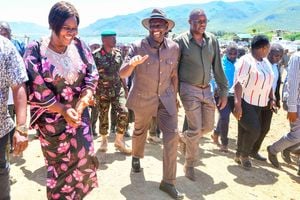
Governor Cecily Mbarire (Embu), Gladys Wanga (Homa Bay), Susan Kihika (Nakuru), Anne Waiguru (Kirinyaga) and US Ambassador to Kenya Meg Whitman at one of the exhibition stands at Tom Mboya University in Homa Bay town on February 27, 2024.
Governor Gladys Wanga put on an impressive show this week, setting a new bar for investment conferences. The second Homa Bay County International Investment Conference (HoBIIC II) attracted thousands of delegates, speakers, investors, financial institutions, as well as the who is who in the political space.
As should be expected of an international conference, it came complete with translation services. Delegates who needed, could follow the proceedings in Mandarin (Chinese) and French.
Investment conferences often suffer from generalities. Usually all they can do is make the claim that there are good investment opportunities in various sectors such as tourism, fishing, agro-processing, mining and so on. They are often stuck extolling the positives of the country or county. Pointing out for example, that the country has a good climate, an educated workforce, good communications and infrastructure. But they lack specific, convincing, bankable, investable projects.
What set the Homa Bay conference apart is the profiles of 42 opportunities that they consider bankable in agribusiness, health, tourism and hospitality, mining, water and sanitation, energy, ICT, industrial, forestry, manufacturing, housing, infrastructure, education and finance. And this is the crux of the matter. An investor with appetite will ask, to whom do I write the cheque? How much ownership does that get me? What is the expected rate of return?
Riwa Special Economic Zone
It is considered best practice for investment promotion efforts and conferences to show concrete results. And not just in the number of attendees, but actual deals being concluded. At the HoBIIC II, nine memoranda of understanding were signed. The County Government got an operator’s license for the Riwa Special Economic Zone (SEZ) while an enterprise based in the SEZ also got a license. All this is great news, particularly if the structuring and project development work is persistent until the proposed projects reach financial close. Still, it can all take time.
One project promoter told me that her team had been working on an energy project for about nine years, including of course, some interruptions like Covid-19, and when a moratorium had been declared on new energy projects. This story mirrors another I heard in the same sector from my neck of the woods in Rumuruti. The lengthy lead times and torturous project development can exhaust all but the most deep-pocketed project developers, and is the bane of greenfield projects in the republic and on the continent.
This is where the one-stop shops are expected to help. Still, for them to be effective, the one-stop shop must be more than a source of information and or licenses. It must have the capacity to move bureaucracy and influence decision making at the very top.
Conferences are great for local hospitality business, and the HoBIIC II was no exception. All hotels, guest houses, inns and boarding houses were full. Some delegates had to stay in Kisumu – a little over an hour away. The counties with a lake front are all working on its development.
One of the purposes of such a conference is positioning. How much mind share does your destination or county get? When folks are thinking of where to holiday or invest, does your county feature?
One of the most impressive exhibitions was by the Kenya Shipyards. They are not just making big boats like the Uhuru II, a specialised vessel transporting petroleum products in the lake Victoria. But if you are looking for a yacht that size, they can make one for you. They make boats for various applications starting with fishing. They are well built using fiber glass. A two-ton vessel, complete with outboard motor will cost you Sh1.3 million. But if you are hauling fish or other cargo, a worthwhile investment.
Not to be left out, the political class was out in full force. Governors, MPs, Cabinet Secretaries, The President, the Prime Minister, former Vice President, and members of county assemblies. The impressive turn-out aside, many stayed on the familiar path and script. Away from the razzmatazz, you would not find them in the breakaway sessions. Yet, it is in such sessions that specifics and technical details are discussed.
Financing infrastructure
There was robust debate among senior officials from the ministries of finance and devolution, and participants, on financing infrastructure at the subnational level. The conversation focused on three topics close to my heart. Own source revenue, equitable share and credit rating. On the first, it emerged that the national government is the biggest defaulter on property taxes, contribution in lieu of rates being outstanding since devolution started.
The erroneous lexicon that the national government “gives” equitable share and conditional grants still persists. It should not. Equitable share is a constitutional dictate. Conditional grants arise when national government wants counties to do its work. Counties can legally turn down the conditional grants they do not want.
But it is credit rating that took centre stage. To attract capital from financial markets – by way of bonds, leasing or PPPs such as tenant purchase, counties must prove themselves creditworthy. One way to demonstrate that is through a credit rating.
The conference attracted 49 partners and sponsors, including advisory firms, traditional banks and financial institutions, guarantee and insurance companies, saccos, pension funds, travel and tech companies.
The entire conference was staged using tents. No brick and mortar halls or break away rooms, begging the question, are conference halls a dying enterprise? Tents are mobile and flexible. Meaning next the event will be in a different ground. And grounds is what Tom Mboya University has.
Altogether an impressive show.
@NdirituMuriithi is an economist







